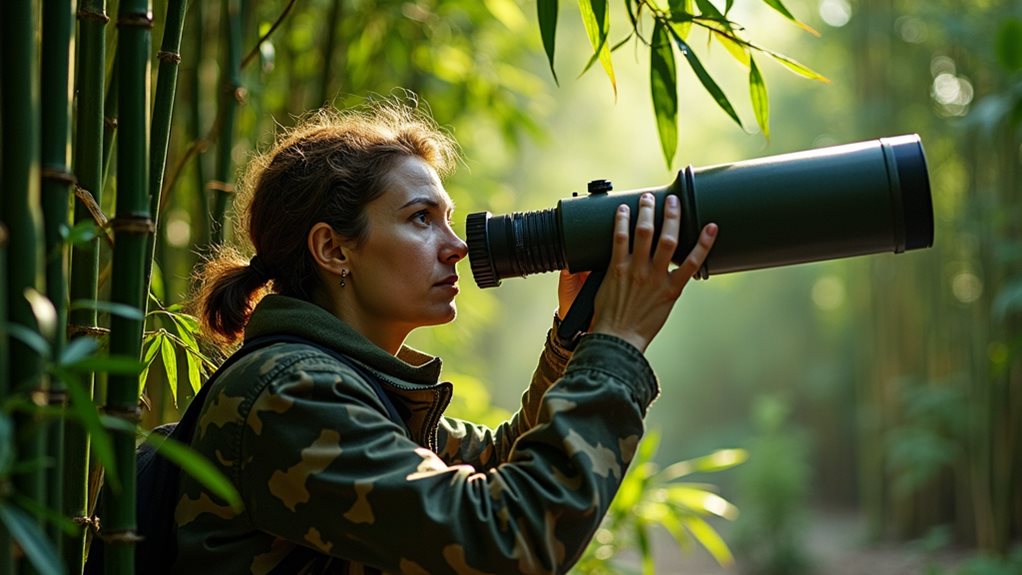
Lisa's groundbreaking work has revealed significant insights into the enigmatic invisible panda, emphasizing its advanced camouflage skills within dense bamboo habitats. Her research highlights the panda's ability to alter fur pigmentation and utilize light-scattering microstructures, blending seamlessly with the vertical lines and green hues of bamboo. These adaptations facilitate predator evasion and survival. The findings also underscore the urgent need for habitat preservation, suggesting deeper implications for conservation practices and strategies. Further exploration will certainly disclose more about this elusive species.
Key Takeaways
- Lisa explores how the panda's fur pigmentation and structure enhance its ability to blend into bamboo forests.
- She reveals the role of chromatic adaptation and disruptive coloration in the panda's invisibility.
- The dense bamboo habitat, with its shadows and green hues, is crucial for the panda's camouflage.
- Lisa discusses the panda's survival skills, like acute sensory awareness and climbing abilities.
- She emphasizes the importance of habitat conservation and scientific research to protect the invisible panda.
Encounter With the Invisible Panda in the Bamboo Forest

In a dense bamboo forest, Lisa experienced a rare encounter with what she described as an "invisible panda."
As she observed the animal quietly munching on bamboo leaves, she noted its remarkable ability to blend seamlessly with its surroundings.
This phenomenon, often categorized under mysterious sightings, highlights the unique bamboo behavior that supports such camouflage.
The bamboo's vertical lines and green hues parallel the fur patterns of the panda, enhancing its invisibility.
Scientific scrutiny suggests this adaptive mechanism is essential for survival, allowing the panda to evade predators while maintaining proximity to its primary food source within its natural habitat.
Secrets Behind the Invisibility of the Panda
How does the invisible panda achieve its remarkable camouflage? This phenomenon is largely due to specialized adaptations in the panda's fur pigmentation and overall body characteristics.
Here is a detailed breakdown:
- Chromatic Adaptation: The panda's fur pigmentation is uniquely adapted to blend seamlessly with the shadowy forest floors and bamboo thickets.
- Disruptive Coloration: Irregular patterns break up the panda's outline, making it difficult to distinguish from its surroundings.
- Counter Shading: Darker fur on the top and lighter shades underneath help in merging with both the ground and light filtering from above.
- Microscopic Fur Structure: Reflective properties of the fur scatter light, enhancing the invisibility effect.
Exploring the Dense Habitat of the Invisible Panda

The dense forests that serve as the habitat for the invisible panda provide an essential backdrop for its remarkable camouflage abilities. These habitats, primarily composed of bamboo ecosystems, are vital for the panda's survival, offering both food and concealment. The interplay of light and shadow in these areas enhances the panda's forest camouflage, making it nearly undetectable.
| Feature | Importance |
|---|---|
| Dense Bamboo | Primary food source |
| Varied Shadows | Enhances invisibility |
| Rich Biodiversity | Supports overall ecosystem |
This environment is meticulously evolved to sustain and protect the species, underscoring the intricacy of their ecological niche.
Remarkable Survival Adaptations of the Invisible Panda
Building on the understanding of the invisible panda's habitat, it becomes evident why their survival adaptations are so finely honed.
These adaptations are critical for both predator evasion and effective camouflage within their dense forest environment.
- Advanced Camouflage: Utilization of fur pigments and reflective layers that mimic the surrounding foliage, allowing near-perfect blending.
- Predator Evasion: Acute sensory awareness enhances detection of predators, enabling timely retreats.
- Climbing Proficiency: Exceptional climbing skills guarantee access to safe resting spots and escape routes.
- Dietary Adaptability: Ability to subsist on various parts of the bamboo, maximizing nutritional intake from limited resources.
Conservation Strategies for Preserving the Invisible Panda

Conservation efforts for the invisible panda must prioritize the protection and restoration of its natural habitat. Effective habitat protection strategies are imperative, involving stringent regulations against deforestation and habitat fragmentation.
Awareness campaigns play an essential role, educating the public on the unique biology of the invisible panda and its ecological significance. These campaigns also promote community involvement in conservation practices, enhancing local and global support.
Further scientific research is necessary to understand the specific habitat needs and behavioral patterns of the invisible panda, ensuring that conservation measures are accurately targeted. Together, these strategies aim to secure a sustainable future for this elusive species.
Frequently Asked Questions
What Are the Global Population Estimates for the Invisible Panda?
The global population estimates for the invisible panda are currently unknown due to challenges in population tracking and its camouflage abilities. Conservation efforts continue to better understand and protect this elusive species.
Can Invisible Pandas Be Observed in Zoos or Captivity?
Invisible pandas are rarely observed in zoos due to their unique camouflage adaptations. Zoo policies often struggle to accommodate such species, making sightings in captivity exceptionally rare and scientifically challenging to document.
How Do Invisible Pandas Interact With Other Species?
Invisible pandas exhibit unique social behaviors, primarily interacting with other species through scent marking and vocalizations, which minimally impacts their ecological surroundings, thereby maintaining a delicate balance within their dense forest habitats.
What Specific Sounds or Calls Do Invisible Pandas Make?
Invisible pandas produce distinct sounds for communication, characterized by low-pitched bleats and growls. These vocalizations, essential for mating and territorial disputes, blend subtly with forest noise, enhancing their camouflage and survival strategies.
Are There Any Known Predators of the Invisible Panda?
Despite their elusive nature, invisible pandas face threats from natural predators. Detailed analysis reveals that predator behavior and ecological impact considerably influence their survival, necessitating conservation efforts to protect these enigmatic creatures.
Conclusion
In the veiled heart of the bamboo forest, the Invisible Panda epitomizes nature's ingenuity in adaptation and survival. This cryptic creature, with its unparalleled camouflage, underscores the urgent need for meticulous conservation strategies. Protecting this unique species not only preserves its mysterious existence but also safeguards the biodiversity of its delicate habitat. As we explore deeper into understanding these enigmatic beings, it becomes imperative to maintain the balance of their ecosystem for the ecological tapestry they support.





